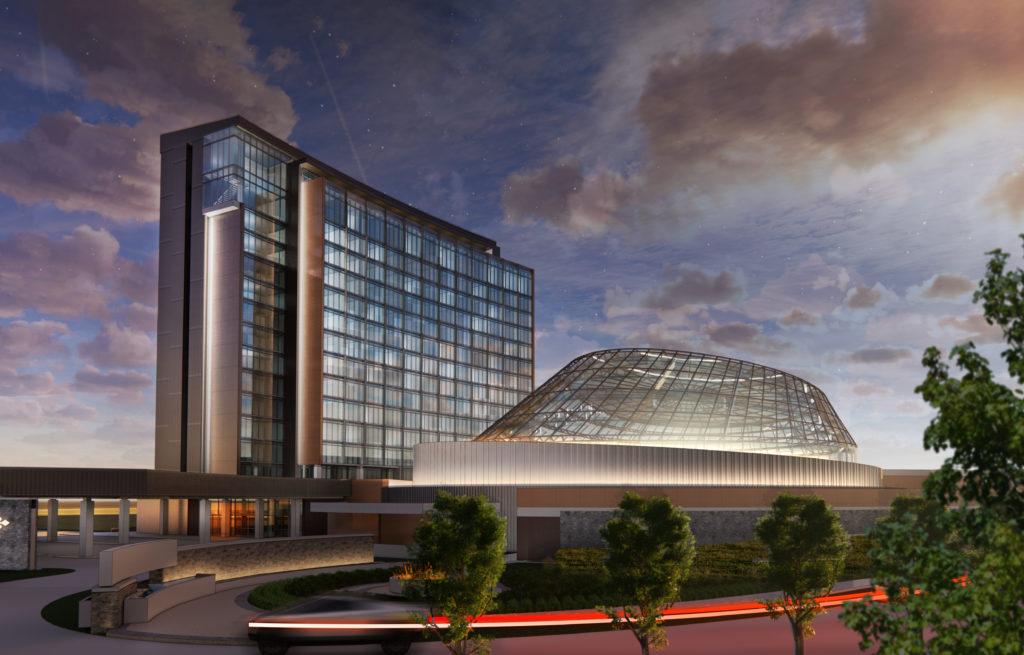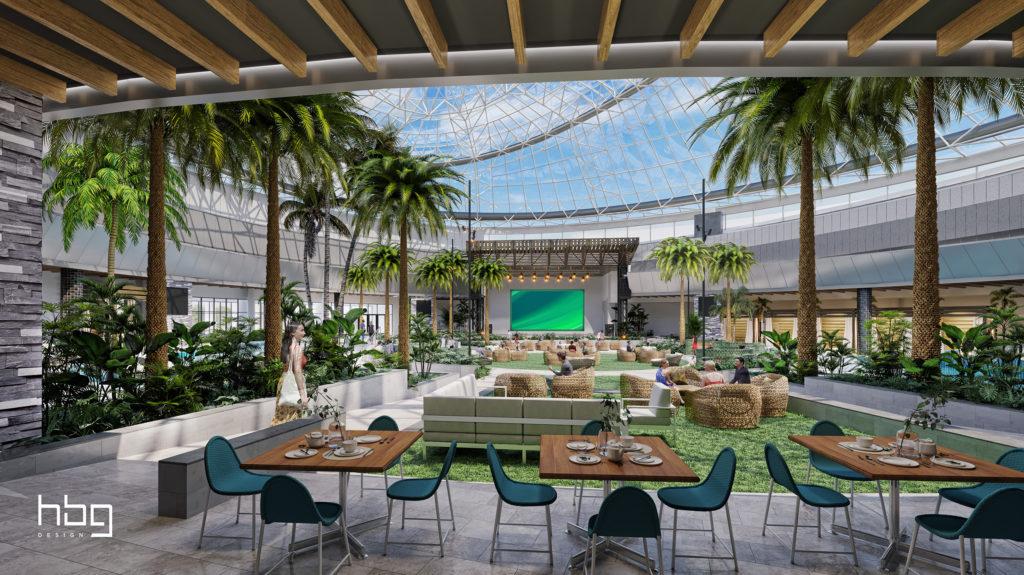READ THE FULL ARTICLE IN GLOBAL GAMING BUSINESS’ TRIBAL GOVERNMENT GAMING MAGAZINE
Tribal Government Gaming Magazine, March 2023
Tribal Casinos 3.0
Integrated resorts were once the bailiwick of Las Vegas and Asia, but today’s tribal casinos are entering that territory eagerly.
Article Excerpt: Loaded Gun

The Gun Lake Casino was just a glimmer in the eye of Michigan’s Match-E-Be-Nash-She-Wish Band of Pottawatomi Indians, better known as the Gun Lake Tribe, when the Mashantucket Pequots opened Foxwoods in the early 1990s. In fact, at that time, the Gun Lake Tribe had only just applied for federal recognition, often a long and drawn-out process. But the tribe had all the required history and could back it up, so five years later, it achieved recognition and began the equally arduous process of taking land into trust for a reservation.
Five years after that, the process was concluded and the tribe hired Station Casinos to build and operate the Gun Lake Casino, which opened in 2011, ushering in a new era of economic prosperity. Station built a serviceable casino for the tribe but it quickly realized something larger would be necessary, and the first expansion was under way. Now in phase five of its expansion project, led by current President and CEO Sal Semola, who was hired following the end of the Station management contract, the Gun Lake Casino is about to add a hotel and a pool and events complex with multiple pools and areas for banquets and entertainment.
Semola came on board at the end of phase four and is enthusiastically supporting the fifth. But even phase five is playing catchup, as the two closest competitors will still have larger properties than Gun Lake.
“When I first came on, I came on midway through what was characterized as the phase three expansion, which was rather modest in the sense it was maybe 100 slot machine additions to the casino floor,” Semola says. “But it was really about a connector building for a parking garage that was needed in anticipation of meeting the needs of future expansions due to the increased traffic and also the depletion of existing surface parking.
“And then phase four, which we just completed in September 2021, consisted of three new F&B outlets and began to set the table for phase five.”
Paul Bell, the lead architect for HBG Design, says the expansion was a reaction to the desires of Gun Lake tribal leadership.
“The Gun Lake owners have set their sights on creating a premier entertainment destination resort in the Midwest,” says Bell. “They want to expand their catchment zone to include larger cities as far away as Chicago and Detroit. I think this fifth phase will create that true super-regional resort with an expansion program designed to drive that traffic in from both of those metropolitan areas.”
Semola explains the location of Gun Lake Casino and why it has been necessary to constantly grow.
“We are just outside of Grand Rapids located off highway 31, which is the north-south artery for Western Michigan,” he says. “So it’s highly trafficked, and we’re equidistant between Grand Rapids, which is the second-largest city in the state, and Kalamazoo, Michigan as well.”
Semola says that the area is growing quickly.
“Our area is somewhat rural—we’re in the town of Wayland—but in just the time that I’ve been here, we’ve seen a lot of growth and development in the area. Even the airport—Grand Rapids International Airport—is undergoing an expansion. And Grand Rapids itself is kind of moving south towards where the casino’s located. So, they’ll continue to benefit from that growth as well.”
Although phase five is the first project that HBG, which has 40-plus other tribal clients, is doing with the Gun Lake tribe, Bell is already impressed with the leadership.
“I and many of my colleagues here at HBG Design we’ve realized that competition in most markets continues to be intense,” he says. “Progressive owners are always elevating their amenity offerings to keep up with that. While the casinos will always have their bread-and-butter patrons at the resort, we also see a continuing trend of owners working to attract more diverse, multi-generational customers through unique out-of-the-box non-gaming amenities, the pool and events complex being a prime example of this.
“In addition, retail, other non-gaming entertainment brings in all ages of people to fit this goal. Owners create through this, these opportunities, a lot more revenue and continue to stay relevant and top-of-mind in the market.”

Bell praises tribal leadership for bringing their vision to the tribal economy. They are currently developing a non-gaming mixed-use development on tribal land that will diversify the economy.
Semola agrees about the foresight of tribal leadership.
“The tribal leaders are extremely forward-thinking,” he says. “I think that when you take into account that they’ve only been on their own, outside of the umbrella of a management company for four years, they’re much further along in terms of that cycle of evolution, in terms of how they look at business and the future. So, as tribal gaming enterprises become more mature over time, they realize that there’s economic opportunities that they can comfortably participate in outside of the sovereignty umbrella, and they become more comfortable investing in that area.”
Bell also credits Semola as being a driving force behind the gaming expansion.
“He has been an absolute joy to work with,” says Bell. “He is a very fun, energetic leader. He’s extremely passionate, an entrepreneurial leader for Gun Lake. He has been engaged in the design process from the beginning. He’s really a key driver in Gun Lake’s long-term development vision.
“I believe beyond what we’re working on with him right now, the current phase five project, as he is constantly looking ahead for new opportunities to identify the next big thing that will attract the market to Gun Lake Casino Resort and maintain a cutting-edge position across the industry and marketplace.”
Semola says the idea for the pool and events complex came to him while he was at a conference at Harrah’s Atlantic City, which has a similar facility, a dome over several pools and hot tubs. But the pool and events complex is different, he says.
“The pool and events complex is designed to be a multi-purpose atrium, and it has three pools. It has a family-oriented pool which is located adjacent to a concession snack bar and some locker rooms. It also has an adult pool that is tiered with a VIP-level pool with a swim up-bar. That creates this great vibrant environment during the day—hot or cold seasons—where their guests can come and enjoy the aqua elements.
“But at night, this facility then converts over to an entertainment facility that is able to provide live performances as well, and sell VIP cabanas and so forth around the pool for those live concerts or DJ dance events, whatever type of entertainment we would choose to engage in based upon their market feasibility and entertainment preferences.”
The tribe chose the right designer for this kind of element—Bell says that although the idea for the pool and events complex came from the tribe, HBG has lots of examples.
“We have done massive atriums in the past for Gaylord resort properties,” Bell says. “One in Orlando, the Gaylord Palms, and we did another one in Grapevine, Texas called the Gaylord Texan. Those were much larger than this. So we have learned through those project experiences how to design a dynamic atrium environment.
“Now while those were designed for a completely different purpose than what this one is designed for, we went to the school of hard knocks on both of those projects. The shape of the pool and events complex really is derived from all the sun angles and site analysis to create an optimal environment for indoor swimming and aquatic activities during the day.”

Semola wanted more from the pool and events complex than just swimming, however.
“We were focused on building a hotel convention space and the pool and events complex, all three of those pieces, from a construction standpoint, from a financial performance standpoint, and without question, the pool and events complex modeled the best,” Semola says. “But what it didn’t give us was that even playing field as it pertains to some of the other casinos in the area, where they could do a sit-down concert or a large banquet. We needed a 2,000-capacity event type of space. So looking at the [complex], the challenge was how, do we get as much versatility in that space as possible?
“Ultimately working with the HBG design team, we came up with the idea of the pools being pushed out of the center, not just one pool, but multiple pools pushed out, which opened up the center. So now we can have that sight line for those types of concerts, or we can just make it a party with a DJ—your typical nightlife. For banquets, we built a production kitchen where we can easily accommodate up to 800 people. We are just looking to try to create as much versatility and utility value out of the space as possible. And I’m really happy with the way that it’s evolved thus far.”
READ THE FULL ARTICLE IN GLOBAL GAMING BUSINESS’ TRIBAL GOVERNMENT GAMING MAGAZINE
